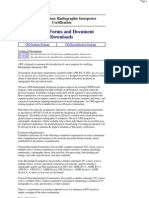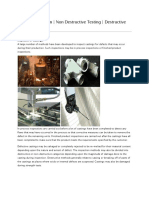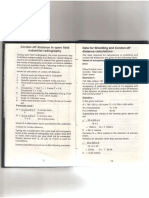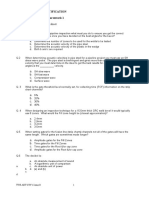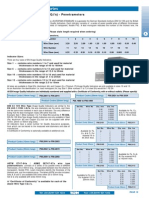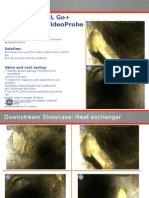Selenium 75
Selenium 75
Uploaded by
vrapciudorianCopyright:
Available Formats
Selenium 75
Selenium 75
Uploaded by
vrapciudorianCopyright
Available Formats
Share this document
Did you find this document useful?
Is this content inappropriate?
Copyright:
Available Formats
Selenium 75
Selenium 75
Uploaded by
vrapciudorianCopyright:
Available Formats
Selenium 75
75
Selenium - Results from on-site Radiography
by MDS Nordion
Agiris Department
Zoning Industriel
B-6220 Fleurus
Belgium
Tel.: +32 71 82 3571 Fax.: +32 71 82 3671 e-mail: support@mds.nordion.be
Index:
1 Introduction
2
75
Selenium Sources
3 Results from on-site Radiography
4 Gamma Radiography Devices
5 Summary
6 References
1 Introduction
Weld inspection on oil and gas pipelines as well as in chemical and petrochemical production
plants has always been one of the most important areas of gamma radiography.
Gammagraphic inspection is performed either in a double-wall single image technique using
conventional portable gammagraphic equipment with the source located outside of the pipe.
Alternatively, self-propelled pipeline crawlers have been designed to travelinside the pipe line.
Gammagraphic weld inspection in the lower range of steel thicknesses has been done with
192
Iridium and
169
Ytterbium isotope sources throughout the past. The large majority of
applications has been using
192
Iridium due to the unfavourable economical parameters of
169
Ytterbium, obviously with non-optimal results at thin wall inspections.
Recently we have made available the isotope
75
Selenium for non-destructive testing. These
sources offer technical specifications as required by industrial applications and provide
various advantages when compared with other radiation sources.
The paper presents the results from systematic comparisons of contrast and resolution
obtained with different types of radiation sources on steel thicknesses from 5 to 40 mm. These
results have been taken into account with the definitions of the European standard for
radiographic inspection of weldments (EN 1435) that is approved since 1997. Conclusions
from practical investigations on pipe line sites, in petrochcemical plants and in nuclear power
stations will be discussed as well. Furthermore, the presentation will stipulate a variety of
advantages obtained from the new source in terms of collimation and radiation protection.
For wall thicknesses of typically 2-30 mm of steel
75
Selenium has meanwhile become well
accepted in international radiography with the clearly legible trend to be the preferential
choice in the near future.
Selenium 75
2
75
Selenium Sources
The main technical specifications of the isotope sources
192
Iridium,
75
Selenium and
169
Ytterbium are included in Table 1. The spectrum of
75
Selenium is dominated by two lines
of energy at 137 keV and 265 keV; the total spectrum consists of nine lines in the range from
66 to 401 keV. The resultant average energy of 217 keV is significantly lower than the
average energy of 353 keV for
192
Iridium. This lower energy provides better contrasts of
radiographs.
Isotope Yb-169
Se-75 Ir-192
Energy Range /kev 63-308
66-401 206-612
Average Energy /keV 145
217 353
Typical. Steel Thickness /mm 2-10
2-30 10-60
Halflife / d 32
120 74
R/(h*Ci) at 1m dist. 0.125
0.203 0.48
Table 1: Characteristic attributes of the isotopes used in gamma radiography of weldments.
Table 2 illustrates the above stipulated differnce of gamma spectra.
Table 2: Gamma ray spectra of
75
Selenium and
192
Iridium.
A further advantage is the
75
Selenium halflife of 120 days, which is 60% more when
compared to
192
Iridium and a factor of approx. 4 when compared to
169
Ytterbium. These
differences turn out to be an important economical aspect when comparing the different
sources, as they are a direct measure of the useful life of sources.
75
Selenium
0
20
40
60
80
100 %
192
Iridium
0
20
40
60
80
100 %
Selenium 75
The short halflife and the very high costs for
169
Ytterbium sources have been the main factors
for the rather low importance of
169
Ytterbium in the full range of gamma radiography.
As visualized by the different radiation constants of 0.48 (
192
Iridium) and 0.203 (
75
Selenium)
exposure times differ by an approximate factor of 2.5 with slight variations depending on the
actual material thicknesses under inspection.
The physical properties of the
75
Selenium also offer big advantages with respect to radiation
shielding and beam collimation. Within the comparison of radiation isodose areas the required
area-radius for a survey of 40Sv/h result in a shut off area that is for
75
Selenium only half the
size as for
192
Iridium. Sources of similar activity and collimators of same absorbtion value
(95%) have been used to obtain values as mentioned in Table 3 below.
Table 3: Radiation isodose radius obtained with 10Ci
75
Selenium and
192
Iridium.
Table 4 shows, the sources are available with physical sizes ranging from 1 mm x 1 mm up to
3 mm x 3 mm. They are produced from firmly compressed selenium pellets of cylindrical
shape. The activities range up to 3 TBq or 80 Ci, which is the maximum allowed loading of
the GAMMAMAT
SE portable isotope transport and working container, as well as the Source
Projector M-Se crawler camera.
Source Dimension
[mm x mm]
Activities
GBq Ci
1.0 x 1.0 74-148 2 - 4
1.5 x 1.5 296-555 8-15
2.0 x 2.0 666 1221 18-33
2.5 x 2.5 1295-2405 35-65
3.0 x 3.0 2400-3000 65-80
Table 4: Source dimensions and activities.
75
Selenium
192
Iridium
R
7
,
2
m
R
5
,2
m
Selenium 75
3 Results from on-site Radiography
Various authors [1, 2, 3, 4, 5, 6, 7] have reported about their results when taking radiographs
of weldments using
75
Selenium and/or
192
Iridium and/or X-rays. A systematic study regarding
the specific contrast as well as the unsharpnesses derived when using CERL double wire
penetrameters has been performed by the Bundesanstalt fr Materialforschung und -prfung
(BAM) [5]. These results have been the basis to suggest the isotope
75
Selenium to be included
in the European standard for radiographic weld inspection (EN 1435) within a thickness range
of 10(14) to 40 mm of steel in class A (B) and down to 5 mm by agreement between the
contracting parties whereas the legal inspection range for
192
Iridium can only be reduced to
10mm. The standard is implemented and in force since October 1997
The results undoubtedly show a significant improvement of contrast of
75
Selenium
radiographs compared to
192
Iridium in the complete range of wall thicknesses as can be
foreseen by the difference in radiation energies.
Under practical conditions this can be measured/visualized by the difference in the detection
of wire IQIs. The published results (e.g. [2,3,4]) show a difference of approximately 1 - 2
wires below 10 mm of steel thickness and 1 wire above in favour of
75
Selenium.
Due to the possibility of selecting the radiation energy of X-ray tubes in accordance with the
material thickness under investigation there is another increase in wire sensitivity at low steel
thicknesses. Starting from approx. 20 - 25 mm steel thickness the differences between X-rays
and
75
Selenium decrease and merge at about 40 mm.
Table 5: Comparison of wire IQI sensitivities obtained with
75
Selenium and
192
Iridium for
different pipe diameters and thicknesses (DW=double wall, SW=single wall)[2].
Se - 75 Ir - 192
6
8
10
12
14
16
N
u
m
e
r
p
r
c
i
k
a
D
I
N
D
I
N
W
i
r
e
N
o
.
Selenium 75
Table 6: Comparison of CERL double wire sensitivity vs. steel thickness for
75
Selenium,
192
Iridium and X-rays [4]
The results regarding resolution as measured by CERL double wire IQIs show results for a
class G2 film very close to those obtained by X-rays. Some results from the large range of
published data are summarized in fig. 5 and 6.
4 Gamma Radiography Devices
For pipelines of diameter less than 6 or those without open end through which a pipeline
crawler can be entered the GAMMAMAT
SE can be used for double wall inspection of
weldments. The GAMMAMAT
SE has already been described in detail elsewhere [1]. This
portable isotope transport and working container is the handiest gammagraphic equipment
available. It offers a maximum loading of 3 TBq (80Ci) of
75
Selenium at an incredibly low
weight of only 7.2 kg, which is a factor of 2 - 3 when compared to variuos
192
Iridium
gammagraphic apparatus. The design is in accordance to the latest draft of ISO 3999 and
offers a unique source safety and control system that is supported by a range of various
accessories. Among others the recently available plug and twist collimators from tungsten
shall be mentioned.
For more than 25 years GAMMAMAT
M self-propelled pipeline crawlers are known for their
outstanding performance and reliabilty in pipeline testing whether it is in coldest polar regions
or hottest dessert surroundings. GAMMAMAT
M travel inside the pipleline and provide the
user with single wall single image radiographs of the welded joints. The small model
GAMMAMAT
M6 can be used in pipelines of diameters ranging from 6to 18, the big
GAMMAMAT
M18 has been designed for use in pipelines with diameters from 18 to 60.
The GAMMAMAT
M isotope pipeline crawlers previously have been used with exposure
cameras for
192
Iridium; the models M6 and M18 used exposure units designed for a maximum
loading of 2.2 TBq (60Ci) and 3.7 TBq (100Ci), respectively.
Introducing the
75
Selenium for gammagraphic weld inspection at significantly improved
quality levels of the radiographs we have also designed an exposure unit for
75
Selenium.
0
0
0,05
0,1
0,15
0,2
0,25
10 20 30 40 50
X-Rays
Se-75
Ir-192
Fe mm
r
e
d
n
i
c
a
p
r
c
i
k
a
D
I
N
C
E
R
L
W
i
r
e
Selenium 75
This unit is fully compatible with both models, M6 and M18. Different from the exposure
units for
192
Iridium, which are Type B(U) containers, the Source Projector M-SE for
75
Selenium is a Type A container with a maximum loading of 3 TBq (80Ci)
75
Selenium. This
new exposure unit is of significantly lower weight comparing to the advantages of the portable
GAMMAMAT
SE apparatus. The most important practical advantage is the use of a standard
75
Selenium link-type source holder as is used with the GAMMAMAT
SE. This provides highest
flexibility for NDT companies working in pipeline inspection by easy way of on-site source
exchange within few minutes.
Practical applications [2] of a GAMMAMAT
M model using the new
75
Selenium crawler
camera loaded with approx. 1 TBq (30Ci) on a pipeline of diameter 12 and wall thickness of
0.25 showed 6-7 m axial distance to the exposed source as limit of the radiation controlled
area (40Sv/h) and 22m perpendicular to the pipeline. Other authors [3] have reported about a
comparison for Ir-192 and
75
Selenium source on a 4.5 diameter pipe and 0.125 steel
thickness; they have found for 0.7 Tbq (18Ci)
75
Selenium a value of 10m behind the film (in
the unshielded beam) comparing under same conditions to approx. 40m for
192
Iridium.
5 Summary
The establishment of
75
Selenium as a source for gamma radiography provides greatly
improved results. Lower gamma ray energies provide greater radiographic contrast, smaller
controlled areas and enhanced radiation protection. A longer halflife ensures economic
benefits. The use of lighter weight exposure containers and crawler projectors has prooved to
be beneficial from the viewpoints of operator productivity and safety.
75
Selenium is included
in the European standrad for weld inspection.
For radiography in wall thicknesses of typically 2-30 mm of steel
75
Selenium has meanwhile
become well accepted in international radiography with the clearly legible trend to be the
preferential choice in the near future.
6 References
[1] C. Sauerwein, G. Isenhardt, R. Link, K. Weinlich; DGZfP Jahrestagung,
Timmendorfer Strand1 (1994)
[2] H. Witte, R. Grimm, G. Isenhardt, C. Sauerwein, U. Ewert; DGZfP Jahrestagung,
Aachen (1995)
[3] H. Thiele, A. Hecht, U. Steinhoff; DGZfP Jahrestagung, Aachen (1995)
[4] U. Ewert; Treatment about the Application Range of
75
Selenium; Bundesanstalt fr
Materialforschung und -prfung (BAM)
[5] J. Mller, S. Rachny, H. Wessel; DGZfP Jahrestagung, Aachen (1995)
[6] U. Ewert, L. Lffler, R. Grimm, C. Sauerwein, J. Mller, H. Wessel, G.-R. Tillack, C.
Bellon; Annual Conference of the British Institute of NDT, Chester (1995)
[7] J.J. Munro III, R. Grimm, T. Kaftal; ASNT Spring Conference, Norfolk VA (1996)
You might also like
- C39 - Fraud Awareness and Prevention - 2015 - AddendumDocument3 pagesC39 - Fraud Awareness and Prevention - 2015 - AddendumNidhi KatyalNo ratings yet
- BS en 13184 2001Document26 pagesBS en 13184 2001vrapciudorianNo ratings yet
- Asme Section V B Se-1419Document8 pagesAsme Section V B Se-1419Monica Suarez100% (1)
- E545-99 Neutron Image QualityDocument4 pagesE545-99 Neutron Image QualityaboutdestinyNo ratings yet
- Mini-Wheel Encoder: Standard InclusionsDocument2 pagesMini-Wheel Encoder: Standard InclusionsGhaith100% (1)
- Ct02 Ect Extended AsmeDocument1 pageCt02 Ect Extended AsmeVasyaNo ratings yet
- Practical MetallographyDocument23 pagesPractical MetallographyvrapciudorianNo ratings yet
- Selenium 75Document5 pagesSelenium 75jimmy david espinoza mejiaNo ratings yet
- Selenium 75, Ir 192 and X-RaysDocument5 pagesSelenium 75, Ir 192 and X-RaysLei LaniNo ratings yet
- Measurement of Prep Ene Trant EtchDocument6 pagesMeasurement of Prep Ene Trant EtchPDDELUCANo ratings yet
- AWS Radio Graphic InterpreterDocument5 pagesAWS Radio Graphic InterpreterShrey Gupta0% (1)
- NDT May-Jun 08Document36 pagesNDT May-Jun 08Abdurohman RawindaNo ratings yet
- Casting Inspection NDTDocument8 pagesCasting Inspection NDTdombipinNo ratings yet
- NDE Associates, Inc. - Ultrasonic Testing - Phased ArrayDocument2 pagesNDE Associates, Inc. - Ultrasonic Testing - Phased Arrayaldeanucu3203No ratings yet
- RT Safe Work Area CalculationDocument10 pagesRT Safe Work Area CalculationMuhammed Hisham H100% (1)
- Radiography TestingDocument1 pageRadiography TestingGulfnde Industrial ServicesNo ratings yet
- Partial List of ISO SpecificationsDocument4 pagesPartial List of ISO Specificationsskynyrd75No ratings yet
- 460 Ewert PDFDocument40 pages460 Ewert PDFdaddadNo ratings yet
- 1100 Gorman RT-UT Presentation For CTMS Oct 07Document29 pages1100 Gorman RT-UT Presentation For CTMS Oct 07Sagar NaduvinamaniNo ratings yet
- Hot Tears in CastingDocument15 pagesHot Tears in CastingRafdi Abdul MajidNo ratings yet
- Metalscan Inspection Services Presents: Nondestructive EvaluationDocument15 pagesMetalscan Inspection Services Presents: Nondestructive Evaluationnaganathan100% (2)
- Sitco H 101 (J) Rev2 - Jis Z 3104 (RT)Document30 pagesSitco H 101 (J) Rev2 - Jis Z 3104 (RT)G_ARVALIS8470No ratings yet
- Neutron RadiographyDocument29 pagesNeutron RadiographyKaitlyn SmallfootNo ratings yet
- AGFA G135 Dev Part A MSDS v1Document10 pagesAGFA G135 Dev Part A MSDS v1RenewiNo ratings yet
- Cordon Off - 4 (00000003)Document1 pageCordon Off - 4 (00000003)Anonymous PlyxbQ3tNo ratings yet
- Ut-Day 3Document21 pagesUt-Day 3DIBYENDU BERA100% (1)
- 4 5847992272976611240 PDFDocument8 pages4 5847992272976611240 PDFAyyappanSubramanianNo ratings yet
- PCN Institute NamesDocument12 pagesPCN Institute NamesGanesh SekarNo ratings yet
- CW1Document6 pagesCW1phutd09No ratings yet
- Magnetic Particle Inspection Handout v1Document109 pagesMagnetic Particle Inspection Handout v1Rawle AssanahNo ratings yet
- Asme Sec V A-2 RT PDFDocument44 pagesAsme Sec V A-2 RT PDFmsalinasaguilar71% (7)
- Holographic and Shearographic NDT Application in Aerospace ManufacturingDocument5 pagesHolographic and Shearographic NDT Application in Aerospace ManufacturingPDDELUCANo ratings yet
- 2012-02-01 FWGIDR 10 Checklist For The Qualification of Digital Detector Array SystemsDocument20 pages2012-02-01 FWGIDR 10 Checklist For The Qualification of Digital Detector Array SystemsDagoberto AguilarNo ratings yet
- IQI Standards of RTDocument1 pageIQI Standards of RTHiren Panchal100% (1)
- Industrial Radiography PDFDocument1 pageIndustrial Radiography PDFLalit MohanNo ratings yet
- RT Pipeline Crawler PDFDocument12 pagesRT Pipeline Crawler PDFAnonymous 5qPKvmuTWCNo ratings yet
- Radiography: J K Singh Lecturer/EMDocument33 pagesRadiography: J K Singh Lecturer/EMmanoj kumarNo ratings yet
- Eddy Current Testing Exam Questions Assignment2Document1 pageEddy Current Testing Exam Questions Assignment2Narotam Kumar GupteshwarNo ratings yet
- Linearity of Equipment GainDocument4 pagesLinearity of Equipment GainReezman MalkeNo ratings yet
- RT SafetyDocument157 pagesRT SafetyYasser Abd El FattahNo ratings yet
- Radiation Guideline: Test Protocols For Parts 2-5Document43 pagesRadiation Guideline: Test Protocols For Parts 2-5Jimmy JohnNo ratings yet
- PT 2Document91 pagesPT 2safeer ahmadNo ratings yet
- Regulatory Guide: June, 2019 PNRA-RG-904.06 (Rev.0)Document40 pagesRegulatory Guide: June, 2019 PNRA-RG-904.06 (Rev.0)Shahbaz AhmadNo ratings yet
- ISO-TC135-SC5 N0220 New Standards On Digital Industrial RadiologyDocument52 pagesISO-TC135-SC5 N0220 New Standards On Digital Industrial RadiologyHappy2021No ratings yet
- The Effect of CarbonDocument4 pagesThe Effect of CarbonkingstonNo ratings yet
- It0704 29Document3 pagesIt0704 29Anonymous avGU1iNo ratings yet
- Interpretasi Film IIWDocument70 pagesInterpretasi Film IIWAhmad RizkiNo ratings yet
- Focal SpotDocument1 pageFocal SpotHappy2021No ratings yet
- Eddy Current Examination of Steel Tubular Products Using Magnetic SaturationDocument2 pagesEddy Current Examination of Steel Tubular Products Using Magnetic SaturationChenjie ZhuNo ratings yet
- Module 5 Radiography TestingDocument121 pagesModule 5 Radiography TestingSajeesh SajiNo ratings yet
- Duplex IQI To en 462Document1 pageDuplex IQI To en 462Jhordy Moises Pinedo CàrdenasNo ratings yet
- ASNTDocument5 pagesASNTshifaNo ratings yet
- ISO - TC 135 - SC 5 - Radiographic TestingDocument2 pagesISO - TC 135 - SC 5 - Radiographic TestingNilesh MistryNo ratings yet
- E428Document6 pagesE428valentinNo ratings yet
- Visual Examination VTDocument1 pageVisual Examination VTramzi5ben5ahmedNo ratings yet
- Bolted Flanged Joint: Flanges, Studs & Gaskets. Recommended Practices for the Assembly of a Bolted Flange Joint.From EverandBolted Flanged Joint: Flanges, Studs & Gaskets. Recommended Practices for the Assembly of a Bolted Flange Joint.No ratings yet
- Challenges in Corrosion: Costs, Causes, Consequences, and ControlFrom EverandChallenges in Corrosion: Costs, Causes, Consequences, and ControlNo ratings yet
- Usm 36 Operation ManualsDocument306 pagesUsm 36 Operation ManualslenaronNo ratings yet
- Examples of Ultrasonic Applications For Nondestructive Testing of PlasticsDocument6 pagesExamples of Ultrasonic Applications For Nondestructive Testing of PlasticsvrapciudorianNo ratings yet
- Thickm W Us NKSVDocument27 pagesThickm W Us NKSVvrapciudorianNo ratings yet
- Conversion FBH To SDHDocument10 pagesConversion FBH To SDHvrapciudorian0% (1)
- Visual Perception of Spatial SubjectsDocument8 pagesVisual Perception of Spatial SubjectsvrapciudorianNo ratings yet
- Damage Evaluation and NDT: Linhas Aéreas InteligentesDocument38 pagesDamage Evaluation and NDT: Linhas Aéreas InteligentesChristian OliveiraNo ratings yet
- The X-Ray Inspection Booklet v7Document86 pagesThe X-Ray Inspection Booklet v7vrapciudorian100% (1)
- Oil&Gas Apps CasesDocument3 pagesOil&Gas Apps CasesvrapciudorianNo ratings yet
- Manual Apollo AnalysisDocument114 pagesManual Apollo AnalysisvrapciudorianNo ratings yet
- GEIT-20120EN TrueDGS Probes DatasheetDocument4 pagesGEIT-20120EN TrueDGS Probes DatasheetvrapciudorianNo ratings yet
- Defectoscopie Nedistructiva IndustrialaDocument514 pagesDefectoscopie Nedistructiva IndustrialaStefan Razvan100% (3)
- US Neutron BackscatterDocument2 pagesUS Neutron BackscattervrapciudorianNo ratings yet
- Battery CapDocument9 pagesBattery CapvrapciudorianNo ratings yet
- Iso - TR - 20172: 2009Document44 pagesIso - TR - 20172: 2009vrapciudorian100% (1)
- Phasor XS Flange Face PaperDocument32 pagesPhasor XS Flange Face PapervrapciudorianNo ratings yet
- API UT-10 TofdDocument24 pagesAPI UT-10 TofdvrapciudorianNo ratings yet
- DIN 1690 P 10 - Technical Delivery Conditions For Castings of Metalic MaterilasDocument7 pagesDIN 1690 P 10 - Technical Delivery Conditions For Castings of Metalic MaterilasvrapciudorianNo ratings yet
- Api Ut 2Document14 pagesApi Ut 2amol1321No ratings yet
- DMS Go Plus Operating Manual EnglishDocument264 pagesDMS Go Plus Operating Manual EnglishvrapciudorianNo ratings yet
- NT TR 427 - Guidelines For Development of NDE Acceptance Criteria - Nordtest Technical ReportDocument23 pagesNT TR 427 - Guidelines For Development of NDE Acceptance Criteria - Nordtest Technical ReportvrapciudorianNo ratings yet
- Immunology Interview Questions - 2022Document4 pagesImmunology Interview Questions - 2022tadeariba1No ratings yet
- Pink Capitalism: Greyer Than It Is Pink: - Aryan DamaDocument4 pagesPink Capitalism: Greyer Than It Is Pink: - Aryan DamaGargi PalaskarNo ratings yet
- 7th Grade Earth SystemsDocument86 pages7th Grade Earth SystemsStephen BestNo ratings yet
- BICC Teoriasec99-9Document63 pagesBICC Teoriasec99-9Martin RojasNo ratings yet
- RC CarDocument11 pagesRC CarJade Panzo SalaspeNo ratings yet
- Gratuity AmendmentsDocument9 pagesGratuity Amendmentsbandgar2002No ratings yet
- Testing of Electrical Installations GuideDocument28 pagesTesting of Electrical Installations Guidetsraj10100% (1)
- 75F Modbus Integration PDFDocument5 pages75F Modbus Integration PDFmohamad chaudhariNo ratings yet
- Temperature and Solvent Effects in The Solubility of Some Pharmaceutical Compounds - Measurement and Modelling PDFDocument9 pagesTemperature and Solvent Effects in The Solubility of Some Pharmaceutical Compounds - Measurement and Modelling PDFClarence AG YueNo ratings yet
- Amanda Norgren - Science Fair Research PaperDocument6 pagesAmanda Norgren - Science Fair Research Paperapi-392717035No ratings yet
- Final ThesisDocument201 pagesFinal Thesisanon-529776100% (5)
- Medication SafetyDocument31 pagesMedication Safetyhogidi2600No ratings yet
- Abm Senior High School StudentsDocument19 pagesAbm Senior High School StudentsShekinah BaguhinNo ratings yet
- EE208 Measurements N InstrumentationDocument2 pagesEE208 Measurements N InstrumentationSangeetha SumamNo ratings yet
- Automotive Digital LibraryDocument31 pagesAutomotive Digital LibraryEdison LemaNo ratings yet
- Carbonyl Compounds Revision Sheet LAYERDocument7 pagesCarbonyl Compounds Revision Sheet LAYERM S RahmanNo ratings yet
- DMT - Synthesis.solid Phase - Resin1Document4 pagesDMT - Synthesis.solid Phase - Resin1Monique Reina LagartijaNo ratings yet
- Writing Task The Strategy of Regional Economic DevelopementDocument4 pagesWriting Task The Strategy of Regional Economic DevelopementyosiNo ratings yet
- Product Information - Healthcare Insurance Employee HandbookDocument20 pagesProduct Information - Healthcare Insurance Employee Handbookrestoreal.mechworkshopNo ratings yet
- Adenovirus: Epidemiology, Spread of Novel Serotypes and in Role With Respiratory Tract InfectionsDocument9 pagesAdenovirus: Epidemiology, Spread of Novel Serotypes and in Role With Respiratory Tract InfectionsIJAR JOURNALNo ratings yet
- How To Register Your Company or LLPDocument8 pagesHow To Register Your Company or LLPanoop82No ratings yet
- Finalpaper Group1 Research GohDocument47 pagesFinalpaper Group1 Research GohLester MallariNo ratings yet
- Latex Slave Sissy Maid _ A Transgender Tale of Mind Control and Forced FeminizationDocument66 pagesLatex Slave Sissy Maid _ A Transgender Tale of Mind Control and Forced Feminizationzaius3955No ratings yet
- PRINCIPLES OF ACCIDENT PREVENTION: After Understanding TheDocument2 pagesPRINCIPLES OF ACCIDENT PREVENTION: After Understanding ThewojakNo ratings yet
- Advocacy in Critical Care - An Evaluation of The Implications For Nurses and The FutureDocument7 pagesAdvocacy in Critical Care - An Evaluation of The Implications For Nurses and The Futureutamidiah533No ratings yet
- NFPA-20-fire Pump ReliefDocument3 pagesNFPA-20-fire Pump ReliefhossameldeenNo ratings yet
- Disaster Monitoring ReportDocument9 pagesDisaster Monitoring ReportJane BonggoNo ratings yet
- Info Sheet Lo2Document8 pagesInfo Sheet Lo2Mario ToloNo ratings yet
- Are You Fit For ISO 16890?: Thomas SchrothDocument16 pagesAre You Fit For ISO 16890?: Thomas SchrothUdhayakumar Venkataraman100% (1)










